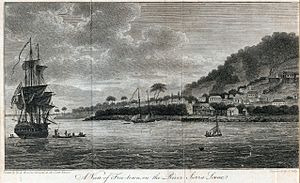Colony of Liberia facts for kids
The Colony of Liberia was a special place started in 1822 by a group called the American Colonization Society (ACS). It wasn't like other colonies because it was set up by a private group, not a country. Later, it became the Commonwealth of Liberia. In 1847, it declared itself an independent country, the Republic of Liberia.
Contents
Liberia's Early Days and Settlements
Liberia was a very unusual colony. Unlike most colonies in the 1800s, it didn't have a formal agreement with a ruling country. It also didn't officially belong to any nation. Instead, it was controlled by the American Colonization Society.
Even after Liberia declared its independence in 1847, many countries didn't recognize it as a new nation. For example, the United States didn't officially recognize Liberia's independence until 1862. This happened during the American Civil War, after the southern states had left the U.S.
The American Colonization Society didn't create Liberia all by itself. Many different settlements joined together to form Liberia. These settlements were started by groups from different U.S. states, like Mississippi-in-Africa and Kentucky-in-Africa. Over time, these separate colonies united to become the Colony of Liberia. In 1839, they formed the Commonwealth of Liberia. This new union was stronger and gave the people more control over their own government.
Getting Ready for a New Home
In 1815, a man named Paul Cuffe tried to create a settlement for freed African Americans on Sherbro Island. However, this attempt failed within five years. The people who survived had to move to Sierra Leone.
In 1816, important leaders like Henry Clay, Robert Finley, and Francis Scott Key formed the American Colonization Society. Their goal was to help freed African Americans move to a new home on the Pepper Coast in Africa.
In 1820, the Society sent a ship called the Elizabeth. On board were three American agents and eighty-six freed people. They sailed to Sherbro Island. Sadly, many colonists and all three agents died from diseases like malaria.
In 1821, another ship, the Nautilus, arrived with more settlers and agents. They quickly decided that Sherbro Island was not a good place to live. They began looking for a better location.
The First Colony is Born
After several tries to find land along the coast, the American Colonization Society sent two agents, Robert F. Stockton and Eli Ayres. Their job was to talk with local chiefs and find a suitable place for a colony.
They held a meeting at Cape Mesurado, which the local people called Ducor. A special agreement, known as the Ducor Contract, was signed. Chiefs from the Gola people, Dei people, and Kru people agreed to give the Society land at Cape Mesurado and on Dozoa Island.
The settlers then created a community on Dozoa Island. They renamed it Perseverance. Life was very hard for these early settlers. Most were free-born African Americans who had not been given full rights in the United States. In Liberia, the local African people often fought against the colonists as they tried to expand.
Despite these challenges, 2,638 African Americans moved to the area over the next ten years. The colony also made an agreement with the U.S. Government. This agreement allowed Liberia to accept enslaved people who were freed from illegal slave ships.
Growing and Expanding
By 1832, the idea of the American Colonization Society had gained a lot of support. Many U.S. states, including New Hampshire, New York, and Ohio, recommended that people support the Society. Many churches across the United States also encouraged people to help.
From the very beginning, the American Colonization Society mostly used white agents to lead the colony. But in 1842, Joseph Jenkins Roberts became the first non-white governor of Liberia. He was a mixed-race, free-born man from Petersburg, Virginia.
In 1847, the leaders of Liberia declared themselves an independent state. Joseph Jenkins Roberts became the first President of the new country.
Challenges for New Settlers
Tropical diseases were a big problem for the people who moved to Liberia. Many new immigrants got sick and died. Between 1820 and 1843, 4,571 people moved to Liberia. But by 1843, only 1,819 of them were still alive. This means about 40% survived.
The American Colonization Society knew that many people were dying. However, they kept sending more people to the colony. Some historians believe that the Society saw themselves as helping people and doing God's work. They thought that problems like disease and death were just tests of their strength. After bad news from Liberia, the Society would just try even harder. They also wanted to keep their organization going. Admitting that the death rate was too high might have meant the end of their project and their jobs.



